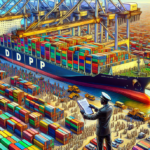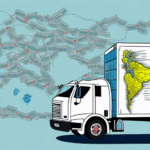Understanding the Different Types of DDP Charges
International trade involves complexities beyond just exchanging goods between two countries. Many aspects must be taken into account, including customs regulations, tariffs, and taxes levied by both exporting and importing countries. In such cases, understanding the different types of shipping terms can be incredibly beneficial. One popular term in international trade is DDP, or Delivered Duty Paid. This article provides a comprehensive overview of DDP charges, explores the various types of DDP, and offers strategies for efficiently managing DDP costs for your organization.
What is DDP and Its Importance in International Trade?
DDP (Delivered Duty Paid) is an international trade agreement where the seller/exporter assumes full responsibility for all costs and risks associated with delivering goods to the buyer/importer at the specified destination. This includes transportation, customs clearance, and payment of taxes and duties. Essentially, DDP represents the highest level of responsibility borne by the seller in shipping terms.
DDP charges are particularly prevalent in cross-border trades, especially in business-to-business (B2B) transactions. For buyers/importers, DDP simplifies the procurement process by providing a clear understanding of total costs upfront, eliminating surprise expenses during transit or customs clearance. Sellers/exporters benefit from DDP by gaining a competitive edge and fostering customer loyalty through reliable and predictable delivery terms.
However, DDP may not always be the best option. If the buyer/importer has a better grasp of local customs regulations and can manage the clearance process more efficiently, alternative shipping terms might be more cost-effective. Additionally, for high-value or fragile goods requiring specialized handling or insurance, negotiating a different shipping agreement may be more appropriate.
The Fundamentals of DDP Charges
Under a DDP agreement, the seller/exporter is responsible for covering the cost of goods, clearance charges, transportation fees, and any taxes or duties imposed by the destination country. DDP charges are comprehensive, typically encompassing all costs associated with the shipment, ensuring the buyer/importer does not incur unexpected expenses.
However, DDP charges can vary significantly based on the destination country's regulations and tax structures. Some countries impose higher taxes or duties on specific goods, increasing overall DDP charges. Additionally, exporters may need to obtain specific licenses or permits for certain countries, further impacting costs. Therefore, it’s crucial for both parties to thoroughly review and understand the terms and conditions of the DDP agreement to avoid unexpected costs or shipment delays.
Types of DDP Charges
DDP charges can vary depending on the nature of the goods, country of origin, and destination country. The primary costs in any DDP agreement stem from duties and taxes levied by both exporting and importing countries.
- DDP Basic: The seller/exporter covers all transportation costs, customs clearance, and pays the required taxes and duties in the destination country.
- DDP with Unloading: In addition to basic DDP charges, the seller/exporter also handles unloading the goods at the importer's port of entry.
- DDP with All Risks: The seller/exporter assumes responsibility for all risks during transportation and delivery, including providing insurance coverage for any potential damages.
- DDP with Storage: This arrangement includes the storage of goods in the destination country, with the seller/exporter covering storage costs until delivery to the importer.
- DDP with Installation: The seller/exporter is responsible for installing the goods at the importer’s location, including labor and equipment costs.
Calculating DDP Charges for Your Shipment
Calculating DDP charges involves several factors, including the type of goods, country of origin, destination country, and specific import regulations and taxes. The general formula for calculating DDP charges includes the price of the goods, transportation charges, insurance costs, customs duties, and taxes.
To determine the total cost:
- Start with the price of the goods, adding any packaging and miscellaneous costs.
- Add transportation fees and insurance costs.
- Calculate customs duties and taxes based on the destination country's regulations.
- Sum all these amounts to obtain the total DDP charges.
DDP charges can vary greatly depending on the destination country's tax rates and import regulations. It's advisable to consult with a customs broker or freight forwarder to ensure accurate and timely calculations.
Common Mistakes to Avoid with DDP Charges
When managing DDP charges, importers and exporters often make several common mistakes:
- Ignoring Custom Clearance Costs: Failing to account for the varying costs of customs clearance in different countries can lead to unexpected expenses and delays.
- Neglecting to Negotiate Terms: Not clearly negotiating and agreeing upon all costs and requirements can result in misunderstandings and transactional friction.
- Inaccurate Valuation of Goods: Incorrectly declaring the value of goods can lead to penalties, delays, or additional costs. It’s essential to accurately assess and declare the value to ensure proper duty and tax calculation.
Proper planning, thorough research, and collaboration with experienced logistics partners can help avoid these pitfalls.
Best Practices for Managing DDP Costs
Effective management of DDP costs involves several best practices:
- Partner with Experienced 3PL Providers: Utilizing third-party logistics providers can help manage customs fees, taxes, and other expenses, keeping costs low.
- Reliable Suppliers/Exporters: Working with dependable partners ensures smoother transactions and better cost management.
- Economies of Scale: Placing bulk orders can reduce per-unit costs and lower overall DDP charges.
- Cost Sharing: Sharing costs with partners can make DDP agreements more economically viable.
Staying Compliant with Customs Regulations When Using DDP
Compliance with customs regulations is essential when operating under a DDP agreement. Importers must understand the specific customs policies and standards of each destination country to ensure full compliance. Non-compliance can result in severe penalties, including fines, seizures, or even imprisonment in extreme cases.
To maintain compliance:
- Stay informed about the latest customs regulations and policies of the destination countries.
- Partner with reliable freight forwarders and customs brokers who can navigate the complexities of international regulations.
- Ensure accurate and complete documentation for all shipments.
Tools and Resources for Simplifying Your DDP Process
Several tools and resources can aid in simplifying the DDP process:
- Online Calculators: Tools that help estimate DDP charges based on various parameters.
- Customs Clearance Software: Software solutions that automate the customs clearance process, reducing manual errors.
- Logistics Software: Comprehensive platforms that manage all aspects of the shipment process, from ordering to delivery.
Additionally, leveraging online resources such as trade forums, trade associations, and government trade websites can keep you updated on the latest regulations and logistical developments in the countries you do business with.
Case Studies: Successful DDP Implementations
Several companies have successfully implemented DDP agreements to enhance their international trade operations:
- Clothing Manufacturer in Bangladesh: Partnered with international logistics providers to establish DDP agreements with global retailers, streamlining the import process and maintaining a steady revenue stream.
- Food Retailer in Australia: Collaborated with a trusted international supplier to set up a DDP agreement, reducing costs, minimizing risks, and ensuring timely delivery of high-quality goods to customers.
These case studies illustrate the potential benefits of DDP agreements, including cost savings, risk mitigation, and improved delivery reliability.
In conclusion, DDP agreements can be a cost-effective and streamlined method for importing and exporting goods. However, thorough research, careful consideration of benefits and risks, and clear contractual agreements are essential to ensure the smooth flow of goods across international borders.




















